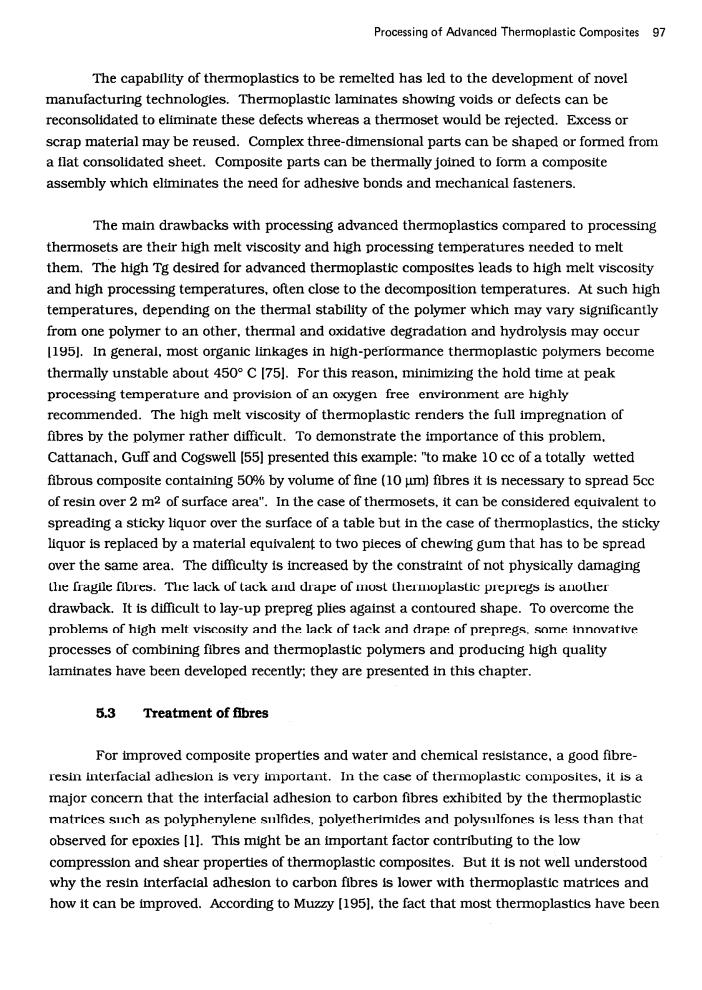正在加载图片...

Processing of Advanced Thermoplastic Composites 97 The capability of thermoplastics to be remelted has led to the development of novel manufacturing technologies.Thermoplastic laminates showing voids or defects can be reconsolidated to eliminate these defects whereas a thermoset would be rejected.Excess or scrap material may be reused.Complex three-dimensional parts can be shaped or formed from a flat consolidated sheet.Composite parts can be thermally joined to form a composite assembly which eliminates the need for adhesive bonds and mechanical fasteners. The main drawbacks with processing advanced thermoplastics compared to processing thermosets are their high melt viscosity and high processing temperatures needed to melt them.The high Tg desired for advanced thermoplastic composites leads to high melt viscosity and high processing temperatures,often close to the decomposition temperatures.At such high temperatures,depending on the thermal stability of the polymer which may vary significantly from one polymer to an other,thermal and oxidative degradation and hydrolysis may occur 11951.In general,most organic linkages in high-performance thermoplastic polymers become thermally unstable about 450C [75].For this reason.minimizing the hold time at peak processing temperature and provision of an oxygen free environment are highly recommended.The high melt viscosity of thermoplastic renders the full impregnation of fibres by the polymer rather difficult.To demonstrate the importance of this problem. Cattanach,Guff and Cogswell (55]presented this example:"to make 10 cc of a totally wetted fibrous composite containing 50%by volume of fine(10 um)fibres it is necessary to spread 5cc of resin over 2 m2 of surface area".In the case of thermosets,it can be considered equivalent to spreading a sticky liquor over the surface of a table but in the case of thermoplastics,the sticky liquor is replaced by a material equivalent to two pieces of chewing gum that has to be spread over the same area.The difficulty is increased by the constraint of not physically damaging the fragile fibres.The lack of tack and drape of most thermoplastc prepregs is another drawback.It is difficult to lay-up prepreg plies against a contoured shape.To overcome the problems of high melt viscosity and the lack of tack and drape of prepregs.some innovative processes of combining fibres and thermoplastic polymers and producing high quality laminates have been developed recently:they are presented in this chapter. 5.3 Treatment of fibres For improved composite properties and water and chemical resistance,a good fibre- resin interfacial adhesion is very important.In the case of thermoplastic composites,it is a major concern that the interfacial adhesion to carbon fibres exhibited by the thermoplastic matrices such as polyphenylene sulfides,polyetherimides and polysulfones is less than that observed for epoxies [1].This might be an important factor contributing to the low compression and shear properties of thermoplastic composites.But it is not well understood why the resin interfacial adheslon to carbon fibres is lower with thermoplastic matrices and how it can be improved.According to Muzzy [195].the fact that most thermoplastics have beenProcessing of Advanced Thermoplastic Composites 97 The capability of thermoplastics to be remelted has led to the development of novel manufacturing technologies. Thermoplastic laminates showing voids or defects can be reconsolidated to eliminate these defects whereas a thermoset would be rejected. Excess or scrap material may be reused. Complex three-dimensional parts can be shaped or formed from a flat consolidated sheet. Composite parts can be thermally joined to form a composite assembly which eliminates the need for adhesive bonds and mechanical fasteners. The main drawbacks with processing advanced thermoplastics compared to processing thermosets are their high melt viscosity and high processing temperatures needed to melt them. The high Tg desired for advanced thermoplastic composites leads to high melt viscosity and high processing temperatures, often close to the decomposition temperatures. At such high temperatures, depending on the thermal stability of the polymer which may vary significantly from one polymer to an other, thermal and oxidative degradation and hydrolysis may occur [ 1951. In general, most organic linkages in high-performance thermoplastic polymers become thermally unstable about 450” C [75]. For this reason, minimizing the hold time at peak processing temperature and provision of an oxygen free environment are highly recommended. The high melt viscosity of thermoplastic renders the full impregnation of fibres by the polymer rather difficult. To demonstrate the importance of this problem, Cattanach, Guff and Cogswell [55] presented this example: “to make 10 cc of a totally wetted fibrous composite containing 50% by volume of fine (10 pm] fibres it is necessary to spread 5cc of resin over 2 ms of surface area”. In the case of thermosets, it can be considered equivalent to spreading a sticky liquor over the surface of a table but in the case of thermoplastics, the sticky liquor is replaced by a material equivalent to two pieces of chewing gum that has to be spread over the same area. The difficulty is Increased by the constraint of not physically damaging the fragile fibres. The lack of tack and drape of most thermoplastic prepregs is another drawback. It is difficult to lay-up prepreg plies against a contoured shape. To overcome the problems of high melt viscosity and the lack of tack and drape of prepregs, some innovative processes of combining fibres and thermoplastic polymers and producing high quality laminates have been developed recently: they are presented in this chapter. 5.3 Treatment of flbres For improved composite properties and water and chemical resistance, a good fibreresin interfacial adhesion is very important. In the case of thermoplastic composites, it is a major concern that the interfacial adhesion to carbon ilbres exhibited by the thermoplastic matrices such as polyphenylene sulfides, polyetherimides and polysulfones is less than that observed for epoxies [ 11. This might be an important factor contributing to the low compression and shear properties of thermoplastic composites. But it is not well understood why the resin interfacial adhesion to carbon fibres is lower with thermoplastic matrices and how it can be improved. According to Musay [195]. the fact that most thermoplastics have been